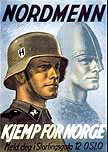
(this page is still slightly under construction)

Schutzstaffel
(Defense Units)
![]()
Originally the personal guard of Adolf Hitler which was transformed by Himmler into a state within a state, an army within an army.
Groupings and Organizations
As the SS developed, it grew new branches and associated organizations. First from the armed group of the general (Allgemeine) SS, Sepp Dietrich was given charge of a special bodyguard, the Leibstandarte Adolf Hitler, which expanded to batallion size; the SS executioners of the Röhm Purge came from this unit. Himmler then proposed to enlarge military SS units to three divisions. After the Minister of War, Blomberg, and the commander of the army, Fritsch, were removed from their posts Hitler had assumed supreme military command. An August 1938 decree added a clear wartime role, as well as an internal political function, to these military SS units (known as SS-VT, Verfügungstruppe, signifying SS troops at the disposal of Hitler or the state).
Concentration camp guards, under Eicke, formed a separate SS unit. At first they wore brown rather than black uniforms with an identifying Death's Head Badge. In March1936 they were officially named the SS Totenkopfverbände (SS Death's Head Units) and the force of 3,500 men was used in camps and for 'special political duties' during the action of taking over Austria and Czechoslovakia. In March 1939 the Waffen SS (armed SS) was formed by combining the SS-VT and the camp guards.
As part of his struggle to wrest power from Frick's Ministry of the Interior, Himmler took control of both the Orpo (Ordnungspolizei), the regulaar uniformed police, and the Sipo (Sicherheitspolizei), the security police. From this base he was able in 1936 to take over the Gestapo as a national organization and replace the former system, based on the separate German states, with a centralized national police system.
Waffen SS
This was the SS army which, at its height, numbered 40 divisions. From its beginnings in the 1920s, the SS had developed a fully armed unit, starting as a bodyguard for Hitler under Sepp Dietrich, but growing in size (as the SS-VT) to two divisions at the outbreak of war. In 1939 an 'armed SS', the Waffen SS, was formed and during 1940 the SS-VT were converted into it. Since voluntary service with the Waffen SS counted as compulsory military service, the Totenkopfverbände (the Death's Head concentration camp guards) were also included in the Waffen SS by an order of March 1940. At this stage, the Waffen SS was not a favored body. The army discouraged recruitment to it and numbers had to be made up with Volksdeutsche, men of German origin living outside Germany and not liable for the call-up to the German army. With expansion in 1942 and 1943, however, when the Waffen SS constituted a full but separate army corps, volunteers for the oversubscribed Luftwaffe and Kriegsmarine were directed into the SS. Almost all of the Hitler Jugend 12 SS Division (see below) were recruited in this way. The expansion continued, but more and more recruits came from outside Germany until it was calculated that of the 900,000 men who served in the Waffen SS, half were non-German. The number who were conscripted or transferred as opposed to SS volunteers is not known.
The qualityof the Waffen Ssdivisions varied greatly. Seven were top-class fighting formations and after their successes in Russia in March 1943 received preference in equipment and were used by Hitler as his elite army. These divisions were:
1 SS Panzer, 'Leibstandarte' (originally Hitler's bodyguard)
2 SS Panzer, Das Reich
3 SS Panzer, Totenkopf
5 SS Panzer, Viking (included Flemish and Scandinavians)
9 SS Panzer, Hohenstaufen
10 SS Panzer, Frundsberg
12 SS Panzer, Hitler Jugend
While these were among the best of the Third Reich's soldiers, these divisions of the Waffen SS also contained a few of the worst in character. It was Das Reich that butchered the French village of Oradour-suur-Glane when their march north was opposed in 1944. Also, the smear of the concentration camps could never be taken from the reputation of the Totenkopf division.
Of the many non-German SS divisions, several Waffen SS divisions were raised by Belo-Russians, Ukranians and Cossaks; and the 30th SS 'Volunteer Grenadier' Division was turned into the Free Russian Army under Vlassov. In the west, SS divisions were recruited from France (SS Charlemagne), from Holland (SS Landstorm Nederland), from Belgium (SS Langemarck and SS Wallonie) and many Scandinavians went to make up SS Viking.
By the end of the war, many units had strayed far from Himmler and Berger's original Aryan ideal (see below). Necessarily there was a considerable variation in fighting prowess between the units, but it remains true that the Waffen SS constituted one of the most formidable military organizations ever developed.
for more information about the Waffen SS, visit the
Waffen SS Archive
 . . . ...
. . . ... . . . . . .
. . . . . .